Edexcel Economics Theme 1
5.0(1)
5.0(1)
New
Card Sorting
1/105
Study Analytics
Name | Mastery | Learn | Test | Matching | Spaced |
|---|
No study sessions yet.
106 Terms
1
New cards
Economics
The study of the allocation of scarce resources.
2
New cards
Economic Goods
Resources that are scarce.
3
New cards
Short Run
A time period where at least one factor of production is fixed.
4
New cards
Long Run
A time period where all factors of production are variable.
5
New cards
Productivity
The output per unit of input.
6
New cards
The Economic Problem
Resources are scarce but wants are infinite.
7
New cards
Scarcity
The world's resources are limited, there are only limited amounts of land, water, oil, food, etc..
Therefore, resources are scarce.
Therefore, resources are scarce.
8
New cards
Free Goods
Goods that are unlimited in supply and therefore have no opportunity cost.
9
New cards
Economic Agents
Consumer, Business and Governments.
Agents involved in Economic transactions.
Agents involved in Economic transactions.
10
New cards
Production Possibility Frontier
The maximum potential output of a combination of goods an economy can achieve when all its resources are fully and efficiently employed, given the level of technology.
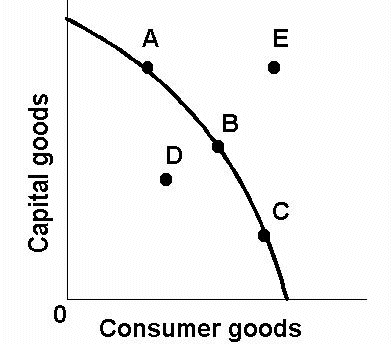
11
New cards
Opportunity Cost
The next best alternative foregone.
12
New cards
Economic Growth
Increase an economy's productive potential.
13
New cards
Capital Goods
Goods intended for use in production, rather than by consumers.
14
New cards
Consumer Goods
Goods designed for use by final consumers.
15
New cards
Renewable Resources
A resource whose stock level can be replenished naturally over a period of time.
16
New cards
Non-renewable Resources
A resource whose stock level decreases over time as it is consumed.
17
New cards
Ceteris Paribus
'All other things (factors) remaining the same'
The assumption that all other variables within a model remain constant whilst the change is being considered.
The assumption that all other variables within a model remain constant whilst the change is being considered.
18
New cards
Positive Statement
A statement based on facts which can be tested as true or false and are value-free.
19
New cards
Normative Statement
A statement based on value judgements which cannot be tested as true or false.
20
New cards
Adam Smith
The Father of Economics;
- The Invisible Hand (workings of the Price Mechanism)
- Specialisation
- Division of Labour
- The Invisible Hand (workings of the Price Mechanism)
- Specialisation
- Division of Labour
21
New cards
Division of Labour
Specialisation of workers on specific tasks in the production process.
22
New cards
Specialisation
The process of breaking down the production process into steps and then each worker is assigned a step. This would then increase labour productivity (Output per Worker).
23
New cards
Barter
An exchange of goods/services for other goods/services.
- Does not involve money.
- Double coincidence of wants.
- Does not involve money.
- Double coincidence of wants.
24
New cards
Money
Anything which is acceptable to a wide number of people and organisations as payment for goods and services.
25
New cards
Free Market Economy
Where all resources are privately owned and allocated via the price mechanism. There is minimal government intervention.
26
New cards
Command Economy
Where there is public ownership of resources and these are allocated by the government.
27
New cards
Mixed Economy
Where some resources are owned and allocated by the private sector and some by the public sector.
28
New cards
Market
A channel where goods and services are exchanged.
29
New cards
Utility
The capacity of a good or service to satisfy some human want.
30
New cards
Rational Decision Making
Where consumers allocate their expenditure on goods and services to maximize utility, and producers allocate their resources to maximize profits.
31
New cards
Demand
The quantity of goods or services that will be bought at any given price over a period of time.
32
New cards
Demand Curve
Shows the quantity of a good or service that would be bought over a range of different price levels in a given period of time.
Slopes downward - Price and Quantity have an inverse (negative) relationship.
Slopes downward - Price and Quantity have an inverse (negative) relationship.

33
New cards
Marginal Utility
The additional satisfaction that a consumer gains for consuming one additional unit of a product.
34
New cards
Diminishing Marginal Utility
As successive units of a good are consumed, the utility gained from each extra unit will fall.
35
New cards
% Change
y2 - y1 / y1 × 100
36
New cards
Price Elasticity of Demand (PED)
The responsiveness of demand to changes in price.
The value is always negative.
% ∆QD / % ∆P × 100
The value is always negative.
% ∆QD / % ∆P × 100

37
New cards
Unitary Price Elasticity (Ped)
Ped = 1
38
New cards
Perfectly Price Inelastic (Ped)
Ped = 0
39
New cards
Price Inelastic (Ped)
Ped is < 1
40
New cards
Perfectly Price Elastic (Ped)
Ped = ∞
41
New cards
Price Elastic (Ped)
Ped is > 1
42
New cards
Total Revenue
Price × Quantity
43
New cards
Income Elasticity of Demand (YED)
The responsiveness of demand to changes in income.
%∆QD / %∆Y × 100
Negative - Inferior Good (Y increases, QD decreases)
Positive - Normal Good (Y increases, QD increases).
%∆QD / %∆Y × 100
Negative - Inferior Good (Y increases, QD decreases)
Positive - Normal Good (Y increases, QD increases).

44
New cards
Negative Income Elasticity of Demand
Inferior Good (As income increases, QD decreases)
45
New cards
Positive Income Elasticity of Demand
Normal Good (As income increases, QD increases)
46
New cards
Cross Price Elasticity of Demand (XED)
The responsiveness of demand for one good to changes in the price of a related good. (Either substitutes or complements).
% ∆ inQD of Good A/ % ∆ in Price of Good B × 100
Negative Value - Complements (The 2 goods are in Joint Demand; as the Price of Good A increases the Demand of Good B decreases).
Positive Value - Substitutes (The 2 goods are in Competitive Demand; as the Price of Good A increases, the Demand of Good B increases.)
% ∆ inQD of Good A/ % ∆ in Price of Good B × 100
Negative Value - Complements (The 2 goods are in Joint Demand; as the Price of Good A increases the Demand of Good B decreases).
Positive Value - Substitutes (The 2 goods are in Competitive Demand; as the Price of Good A increases, the Demand of Good B increases.)

47
New cards
Negative Cross Price Elasticity of Demand
Complements (As the Price of one good increases, the Demand for the second good decreases)
The 2 goods are in Joint Demand.
The 2 goods are in Joint Demand.
48
New cards
Positive Cross Price Elasticity of Demand
Substitutes (As the Price of one good increases, the Demand for the second good increases)
The 2 goods are in Competitive Demand.
The 2 goods are in Competitive Demand.
49
New cards
Supply
The quantity of a good or service that firms are willing to sell at a given price over a given period of time.
50
New cards
Supply Curve
Shows the quantity of a good or service that firms are willing to sell to a market over a range of different price levels in a given period of time.
An upward sloping curve - Price and Supply have a direct relationship.
An upward sloping curve - Price and Supply have a direct relationship.

51
New cards
Price Elasticity of Supply
The responsiveness of supply to changes in price.
Pes = %∆QS / %∆P
Pes = %∆QS / %∆P
52
New cards
Equilibrium Price
The price at which the Quantity Demanded and Quantity Supplied are equal, ceteris paribis. "Market Clearing Price"
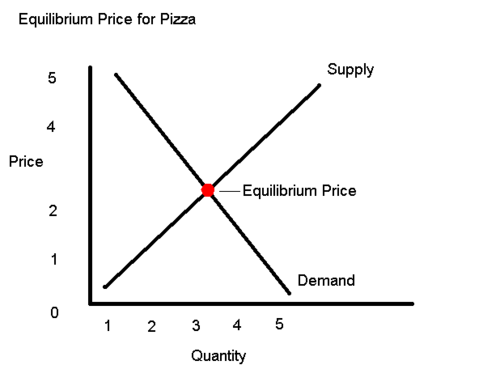
53
New cards
Excess Supply
Where the QS exceeds the QD for a good at the current market price.
QS > QD
QS > QD

54
New cards
Excess Demand
When the QD exceeds the QS for a good at the current market price.
QD > QS
QD > QS
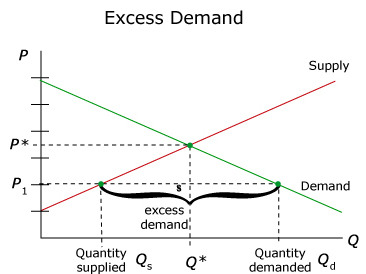
55
New cards
Adam Smith's Invisible Hand
A hidden hand of the market operating in a competitive market through the pursuit of self-interest allocated resources in society's best interest.
56
New cards
Price Mechanism
The use of market forces to allocate resources in order to solve the economic problem of what, how, and for whom to produce.
The interaction of demand and supply to determine the market clearing price.
The interaction of demand and supply to determine the market clearing price.
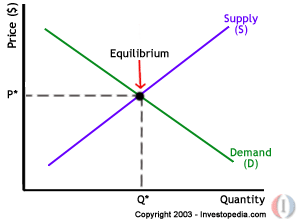
57
New cards
Consumer Surplus
The difference between how much buyers are prepared to pay for a good and what they actually pay.
It is represented by the area under the demand curve above the ruling market price.
It is represented by the area under the demand curve above the ruling market price.
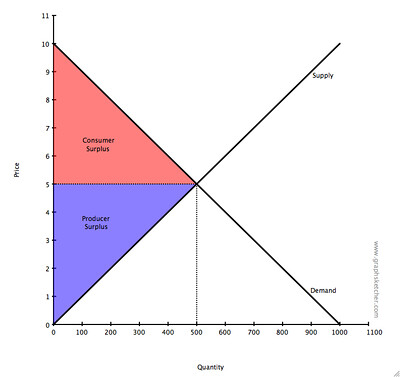
58
New cards
Producer Surplus
The difference between the market price which firms receive and the price at which they are prepared to supply.
It is represented by the area below the ruling market price and above the supply curve.
It is represented by the area below the ruling market price and above the supply curve.

59
New cards
Tax Incidence when Demand is Inelastic
Consumer Tax Burden > Producer's Tax Burden
60
New cards
Tax Incidence when Demand is elastic
Consumer Tax Burden < Producer's Tax Burden
61
New cards
Tax Incidence when Supply is Inelastic
Consumer Tax Burden < Producer's Tax Burden
62
New cards
Tax Incidence when Supply is elastic
Consumer Tax Burden > Producer's Tax Burden
63
New cards
Direct Taxes
Tax paid on incomes or profits.
Example; Income Tax and Corporation Tax.
Example; Income Tax and Corporation Tax.
64
New cards
Indirect Taxes
A tax levied on the purchase of goods and services. It includes both specific and Ad Valorem taxes.
Its shown by an inward shift of the supply curve.
Its shown by an inward shift of the supply curve.
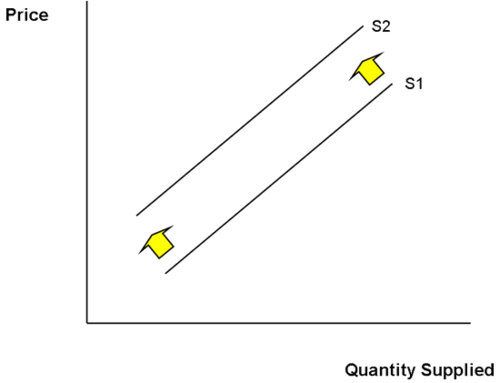
65
New cards
Specific Tax
The amount of tax levied does not change with the value of the goods but with the amount or volume of goods purchased (Excise Duties)
- Parallel to the 1st Supply Curve
- Parallel to the 1st Supply Curve
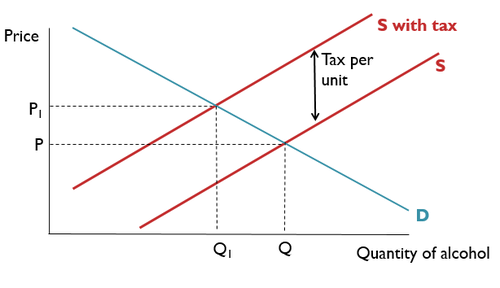
66
New cards
Ad Valorem Tax
Tax levied increases in proportion to the value of the tax base. (VAT)
- Steeper Gradient relative to the original Supply Curve.
- Steeper Gradient relative to the original Supply Curve.
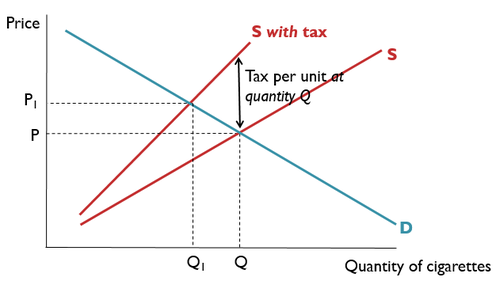
67
New cards
Incidence of Tax
The distribution of the tax paid between consumers and producers.
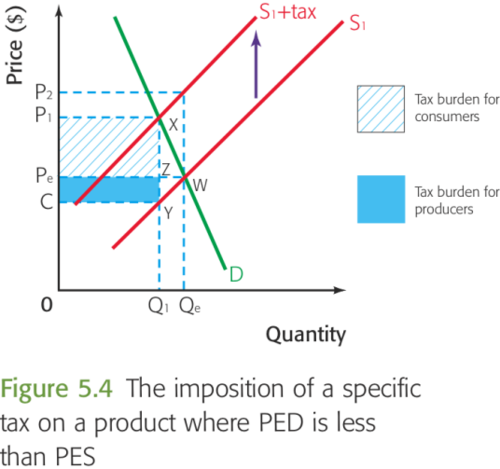
68
New cards
Consumer Tax
Below the new EQ and above the original EQ.
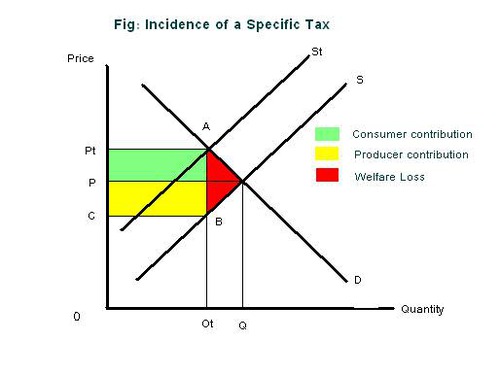
69
New cards
Producer Tax
Below the original EQ and above the original supply curve.
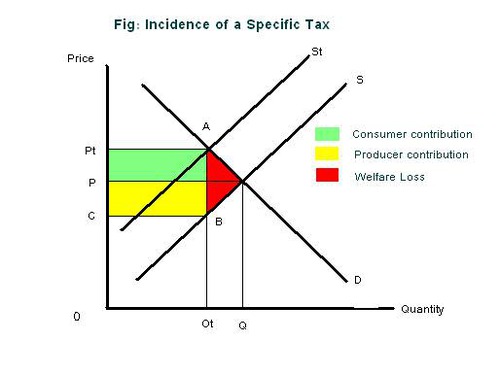
70
New cards
Subsidy
A government grant to firms, which reduces production costs and encourages an increase in output.
Its shown as an outward shift of the Supply Curve.
Its shown as an outward shift of the Supply Curve.
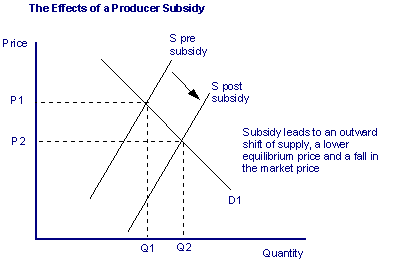
71
New cards
Market Failure
A misallocation of resources caused by the Market Mechanism.
72
New cards
Reasons for Market Failure
- Missing Markets ( Merit Goods and Public Goods)
- Lack of Competition in the market.
- Externalities
- Imperfect Market Information
- Factor Immobility
- Inequality
- Lack of Competition in the market.
- Externalities
- Imperfect Market Information
- Factor Immobility
- Inequality
73
New cards
Demerit Goods
A good which is over provided by the Market Mechanism and tends to yield more costs to individuals than they realize.
Examples; Tobacco, Drugs, Alcohol, etc..
Examples; Tobacco, Drugs, Alcohol, etc..
74
New cards
Externalities
The costs or benefits that are external to an exchange. They are 3rd party effects ignored by the Market Mechanism.
75
New cards
Consumption Externality
An external cost or benefit arising from a consumption activity.
76
New cards
Production Externality
An external effect of production, which neither harms nor benefits the person or firm controlling the production.
77
New cards
External Costs
Negative 3rd Party effects that are excluded from the Market Mechanism.
78
New cards
Private Costs
Cost internal to a market transaction, which are therefore taken into account by the Market Mechanism.
79
New cards
Social Costs
External Costs + Private Costs.
80
New cards
External Benefits
Positive 3rd Party effects that are excluded from the Market Mechanism.
81
New cards
Private Benefits
Benefits internal to a market transaction, which are therefore taken into account by the Market Mechanism.
82
New cards
Social Benefits
External Benefits + Private Benefits.
83
New cards
Market Equilibrium Level
Marginal Private Costs (MPC) = Marginal Private Benefits (MPB)
84
New cards
Social Optimum Level
Marginal Social Costs (MSC) = Marginal Social Benefits (MSB)
This is where society should be.
This is where society should be.
85
New cards
Welfare Loss
The excess of social costs over social benefits for a given output.
A situation where MSB is ≠ to MSC and society does not achieve maximum utility.
A situation where MSB is ≠ to MSC and society does not achieve maximum utility.
86
New cards
Welfare Gain
The excess of social benefits over social costs.
87
New cards
Negative Production Externality
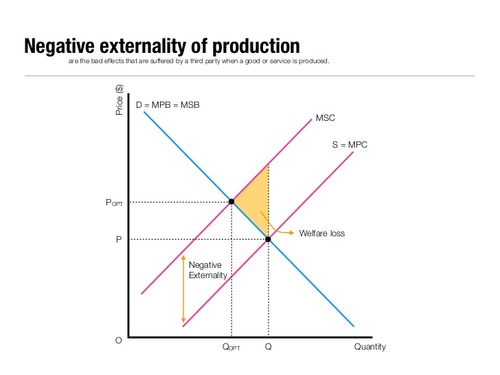
88
New cards
Positive Consumption Externality
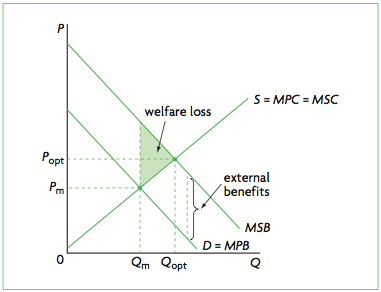
89
New cards
Internalising the Externality
Eliminating the externality by bringing it back into the framework of the Market Mechanism.
= Creating a market for the Externality.
Examples; Tradable Pollution Permits, Extending Property Rights, Taxes, Regulation, etc..
= Creating a market for the Externality.
Examples; Tradable Pollution Permits, Extending Property Rights, Taxes, Regulation, etc..
90
New cards
Public Goods
Those goods that have non-rivalry and non-excludability by their consumption.
Non Rivalry; Consumption of goods by one person does not reduce the amount available for consumption by another.
Non-Excludable; Once provided, no person can be excluded from benefiting.
Examples; Defense, Police Service, Street Lighting, Judiciary and Prison Service.
Non Rivalry; Consumption of goods by one person does not reduce the amount available for consumption by another.
Non-Excludable; Once provided, no person can be excluded from benefiting.
Examples; Defense, Police Service, Street Lighting, Judiciary and Prison Service.
91
New cards
Private Goods
Those goods that have rivalry and excludability in their consumption.
92
New cards
Free Rider Problem
If left to the free market, public goods would not be adequately provided for.
The market fails because firms cannot withhold the goods and services from people who refuse to pay.
The market fails because firms cannot withhold the goods and services from people who refuse to pay.
93
New cards
Information Gaps
Where consumers, producers or the government have insufficient knowledge to make rational economic decisions.
94
New cards
Symmetric Information
Where consumers and producers have access to the same information about a good or service in a market.
95
New cards
Asymmetric Information
Where consumers and producers have unequal access to information about a good or service in the market.
96
New cards
Maximum Price
A ceiling price set by the government on a good or service, above which it cannot rise. It may be enforced through government legislation.
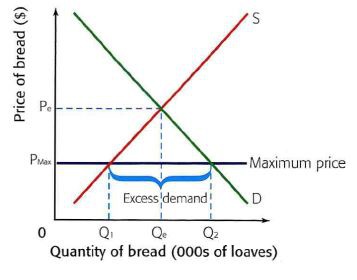
97
New cards
Minimum Price
A floor price set by the government on a good or service, below which it cannot fall. It may be enforced through government legislation.
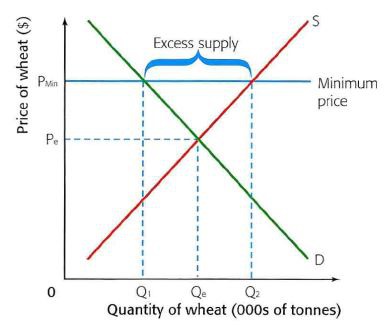
98
New cards
Guaranteed Minimum Price
Where the surplus output created is purchased by a government agency at the minimum price. The main aim of such a scheme is to protect producer incomes.
99
New cards
Tradable Pollution Permits
Pollution permits that can be bought and sold in a market. They are an attempt to solve the problem pf pollution by creating a market for it.
100
New cards
Extending Property Rights
Water companies are given the right to charge companies which dump waste into the rivers or the sea.
A way of internalising the externality.
A way of internalising the externality.